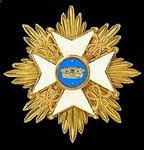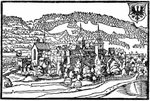Chefs: 31st May 1756 Lieutenant General Friedrich, hereditary Prince of Hesse-Kassel; 8th January 1757 Colonel Friedrich Wilhelm von Salmuth, called Beringer, later Major General; 28th April 1763 to 1766 Major General Karl Friedrich von Beckwith, until then chief of the Prussian Legion in the allied army of Duke Ferdinand of Braunschweig
First raised 1756 from the Minden Garrison Battalion XIII Salmuth and various recruits via other regiments. In 1756 it remained in Wesel. When Wesel was evacuated in March 1757 it marched to Bielefeld and fought the French in July when its commander, Colonel von Salmuth, was defending Geldern. Commanded by the King to move to Magdeburg it lost 320 men by desertion. The grenadiers fought at Prague and Leuthen.
In 1758 it belonged to Prince Heinrich's Corps and after August took part in Wedell's advance against the Swedes. Then it became part of the garrison of Dresden when Daun's army crossed the Elbe in November; the King came to Dresden on November 20th and the Austrians retired.
In 1759 it was back in the Saxon Corps and as usual marched around a lot. In May under the command of Schenkendorff it attacked Austrian light troops at Aue and drove them back. The main Prussian forces now withdrew to fight the Russians leaving the Imperial army almost free rein in August. The 1st Battalion of IR48 evacuated Leipzig in return for a guarantee of free departure. The 2nd Battalion was in Dresden along with 5 other battalions. Count Schmettau refused calls to surrender and prepared to defend the city but, having received a letter from the King, after Kunersdorff, giving him permission to evacuate the city if necessary so long as free departure was allowed, he did so on September 4th. Too late the King announced that he was coming to relieve the city. In September the 2nd Battalion joined Finck's Corps and then joined up with the 1st Battalion which had defended Torgau. On the 21st September both were at the combat of Korbitz. It was also at the combat of Pretzsch on October 29th.
In 1760 it was with the King in his advance on Dresden in July but then withdrew with the army as the siege train failed to arrive. On August 20th under Hülsen it held off three times its numbers at Strehla and then fell back to Belzig and Beelitz in early October. Saxony was abandoned.
In 1761 it was with Prince Heinrich again, holding the position on the Mulde. In 1762 it waas on the Elbe bridgehead between Dresden and the Erzgebirge. At Brand on October 15th it was driven back to Freiberg by the Imperial Army with heavy losses and captured. But the battle of Freiberg overturned all Austrian hopes of ultimate victory in the war.
Christopher Duffy in his Army of Frederick the Great says: "Raised from a garrison battalion. ... the regiment saw little action in the Seven Years War". It certainly did a lot of marching, garrisoning and evacuating!
And this was the uniform in 1756:



















